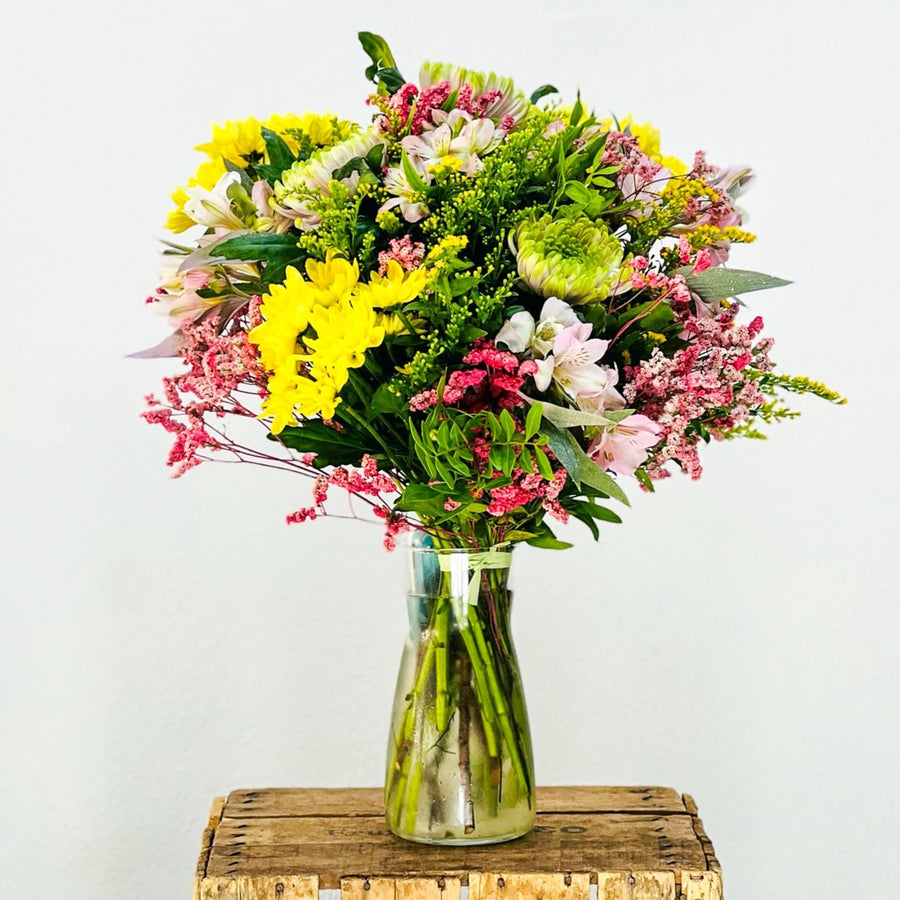Daisies
Daisies are, without a doubt, one of the most iconic and recognizable flowers in the world of gardening and floral decoration. These beautiful flowers, known for their simplicity and charm, have captivated gardeners and floral artists for centuries. In this article, we will explore the fascinating world of daisies, from their origin to their various varieties and their symbolic meaning.
Origin and Distribution
Daisies, whose scientific name is "Bellis perennis," have a history dating back centuries to the regions of Europe and Western Asia. Its scientific name, "perennis," is derived from Latin and means "perennial" or "eternal," which refers to its ability to bloom year after year. These charming flowers have captured the imagination of people around the world due to their simple beauty and ease of cultivation.
Although their origin is in Europe and Western Asia, daisies have managed to naturalize in a wide variety of habitats throughout the planet. Their adaptability has made them one of the most widely distributed flowers on Earth. From the cold regions of Scandinavia to the warm fields of North America and beyond, daisies have found their place on almost every continent. For example, there is the African daisy.
These flowers are not picky when it comes to the environment in which they grow. They thrive in temperate climates, but their hardiness allows them to survive in less than ideal conditions. You can find daisies in a variety of places, from fields and meadows to gardens and flower beds, where they add a touch of elegance and joy with their simple but charming appearance.
One of the most common places to find daisies is along roads. Their hardy nature allows them to grow on marginal land, often in places where other flowers could not survive. These wild daisies add a touch of beauty to landscapes along highways and paths, offering an unexpected gift for those who admire them while traveling.
The wide distribution of daisies not only makes them prized for their beauty, but also makes them a symbol of perseverance and adaptability in nature. The ability of these flowers to flourish in various conditions and in different corners of the world makes them truly remarkable and valuable to botany and human culture.
Height and Appearance
Regarding their height, daisies are small herbaceous plants that can reach between 15 and 30 cm in height. These modest dimensions make them a popular choice in both gardens and floral bouquets. Despite their modest size, daisies radiate a beauty that does not go unnoticed.
The stems of daisies are slender and elegant, allowing the flowers to rise gracefully above the surrounding foliage. This feature contributes to their visual appeal, as the daisies appear to float in the air, like small white clouds dotted with light.
The most distinctive part of a daisy is, without a doubt, its flower head. Each flower consists of a yellow or golden center, which is often described as a disc. This central disc is like the heart of the daisy, and its bright color adds an attractive contrast to the surrounding petals. The petals, usually 15 to 30 in number, surround the central disc in a radial arrangement. They are pure white, creating a charming effect of freshness and purity.
Despite the predominance of daisies with white flowers, there are variations that present a more diverse color palette in full sun. Some varieties, such as the Pomponette Daisy, feature delicate pale pink petals, adding a touch of romance to their appearance. You can even find daisies with petals in deeper shades of red and pink, which offer a bolder, more striking look. The variety of colors available allows flower lovers to incorporate daisies into a variety of floral compositions and color palettes, adapting them to their preferences and stylistic needs.
Daisy care
The daisy is a hardy and easy-care plant, but to ensure they bloom healthily and look their best, here are some essential tips:
-
Sunshine:
-
Daisies do best in full sun. Find a location in your garden or indoors where they receive at least 6 hours of direct sunlight per day. This will ensure vigorous growth and abundant flowering.
-
-
Soil and Drainage:
-
Make sure the soil has good drainage and organic matter. Daisies do not tolerate waterlogging, which can cause root diseases. A sandy or slightly alkaline soil is ideal.
-
If you have heavy or poorly draining soils, you can improve the situation by adding sand or perlite to increase drainage capacity.
-
-
Irrigation:
-
Keep the soil evenly moist, but not soggy. Water daisies at the base, avoiding wetting the flowers and leaves to reduce the risk of fungal diseases.
-
In hotter, drier climates, you may need to increase the frequency of watering, but always allow the soil to dry slightly between watering to avoid root rot problems.
-
Varieties of Daisies
There are numerous varieties of daisies, each with its unique characteristics. Some of the most notable include:
-
Meadow Daisy (Leucanthemum vulgare): This is the most common variety of daisy and is characterized by its white petals and bright yellow center. It is widely used in gardening and flower bouquets.}
-
Shasta Daisy (Leucanthemum × superbum): With white petals and a larger yellow center, the Shasta Daisy is a very popular hybrid variety in gardening.
-
Pomponette Daisy (Bellis perennis "Pomponette"): This variety has pale pink petals, giving it a distinctive and romantic appearance.
-
Gerbera Daisy (Gerbera jamesonii): Although not in the same family as traditional daisies, the Gerbera Daisy is known for its vibrant colors and large flowers, which can be red, orange, yellow, pink or white.
Lifespan
Daisies are perennial plants, meaning they can live for several years if properly cared for. In gardening, they are often grown as annuals, replanting each season to keep a garden fresh and vibrant.
Symbolic Meaning
In popular culture, daisies are often seen as a symbol of purity and innocence . Its simple appearance and snow-white (or even yellow flowers) color evoke a feeling of cleanliness and freshness. This connotation of purity also stems from the fact that daisies typically bloom in the spring, a season that is associated with rebirth and renewal. As a result, daisies have been a common choice for events and celebrations that celebrate special and pure moments in life every 15 days, such as weddings and baptisms.
In addition to their representation of purity, daisies are also associated with simplicity. In an often complicated and frenetic world, these flowers offer a reminder of the beauty in simplicity. Its unassuming form and structure serve as a reminder that true beauty can be found in the simple things in life.
Daisies are also considered a symbol of eternal youth and lasting beauty. Their ability to bloom year after year and their resistance in various climatic conditions have led to the interpretation that these flowers embody eternal youth and the ability to maintain beauty over time. Therefore, giving daisies can be a loving way to praise someone's lasting beauty or celebrate the vitality of youth.
In the language of flowers, known as "floriography," daisies have a particularly pleasant meaning. Giving daisies can express feelings of love and friendship. Daisies convey a message of affection and closeness, making them a perfect choice for gifts to friends and loved ones. They can also symbolize loyalty and commitment in a relationship.
Floral Combinations
Daisies pair well with a variety of other flowers in floral arrangements and bouquets. Some popular options include:
-
Roses: The combination of daisies with roses creates a balance between simplicity and elegance.

-
Chrysanthemums: Daisies beautifully complement the color and scent of chrysanthemums.

-
Lilies: Combining daisies with lilies creates eye-catching and sophisticated floral arrangements.
In short, daisies are a lovely and versatile choice in the world of flowers. With their European origin, diverse varieties, durability, and deep symbolic meaning, these flowers continue to captivate people around the world. Whether in a garden, in a bouquet or on a special occasion, daisies add beauty and elegance to any setting.

